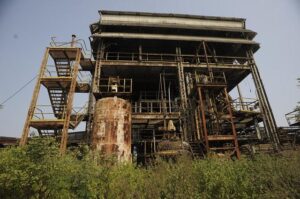The Hindustan Times reports that the Madhya Pradesh state government plans to dispose of 346 tonnes of toxic waste, from the abandoned Union Carbide factory, at a Pithampur-based treatment, storage and disposal facility. Whilst, in principle, we support the idea of removing toxic waste from this crumbling, derelict site we feel it necessary to explain a number of problems with this apparently worthwhile idea.
Firstly, the waste being discussed is stored above ground and is relatively safely contained but, dotted around the factory site, are numerous unlined pits where vast quantities of dangerous chemical waste remain buried. Outside of the factory walls lie the remains of three enormous solar evaporation ponds to which toxic waste was pumped as liquid effluent. The ponds were known to have been leaking even before the gas disaster and, thus, leaching their contents into the groundwater aquifer. Between the unlined pits and the solar evaporation ponds there are literally THOUSANDS OF TONNES of toxic waste that urgently need removal or treatment.
It is this waste, not discussed in the current plan, that is contaminating the groundwater aquifer for miles around the abandoned factory, creating a major public health crisis, and a major worry remains that the above ground waste removal might act as a smokescreen in front of the main chemical waste disposal issue. Simply put, the more clean the abandoned site becomes, above ground, then the harder it becomes to make the case concerning that which cannot be seen.
The second main problem with the proposed waste disposal plan is that a serious doubt remains over whether the plant actually has the technical capability to dispose of the Union Carbide waste in a safe manner and these concerns do not seem to have been answered. If the plant does not treat the waste absolutely effectively then it will spew dioxins all over the surrounding area- and the nearby housing.
The company that owns the Pithampur facility has failed to install the necessary ‘Multiple Effect Evaporator’ despite several reminders from the Madhya Pradesh Pollution Control Board (MPPCB) over the last five years. Using a multiple-effect evaporator the hazardous substances are mixed with water and the MEE then evaporates this water in minute particles ensuring the minimum environmental impact.



